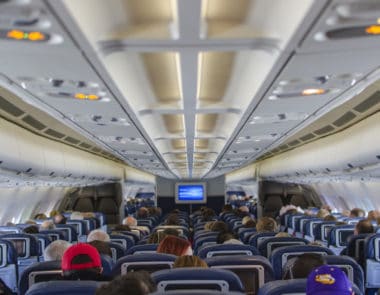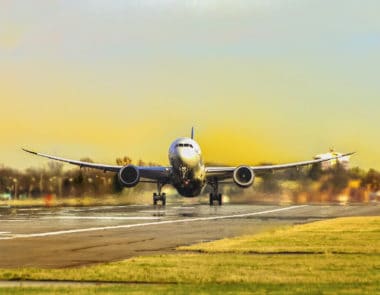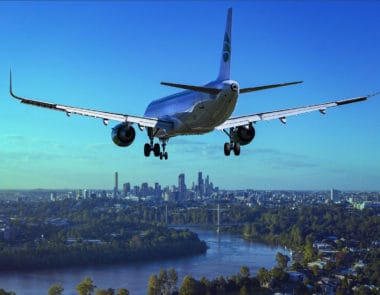How Early Should I Get to the Airport? When to Arrive to the Airport for a Flight 2025
We’ve all been there before. The day before your flight, you start calculating the hours in your head. How early will you need to wake up to make that early-morning flight (or even a mid-morning flight)? How long will it take you to get out of the house and park in the airport lot? Will the security lines be bad at that particular time of day?
Make the wrong calculation and you’ll end up missing your flight. On the other hand, you could make a wrong calculation in the other direction. Then you end up sitting in the airport for hours. And no one wants to be stuck drinking at the airport bar for two hours pre-flight. You don’t even want to be stuck watching all those downloaded shows you were saving for your red-eye. You don’t want to be stuck in the airport at all!
So how can you go about giving yourself the best chance at striking the perfect balance? How do you allow for enough time to go through all the airport checks and balances without feeling rushed and harried? But while also not giving yourself so much time that you grow bored and blah?
Here are our top tips for arriving at the airport right on time.
The Vacationer Tip
Before learning how early to get to the airport, check out our guide on How to Find and Book Cheap Flights. Also, don’t forget to leverage your airline credit card to save even more money when you travel. If you do not have a travel-rewards credit card, our highest recommendations are the Chase Sapphire Preferred® Card, the Capital One Venture X Rewards Credit Card, and the Citi Premier® Card. If you would like to see other offers, Click to See All of Our Recommended Travel Credit Cards.
Table of Contents
Arriving at the Airport for Domestic Flights
The top factor that will impact how early you should arrive at the airport? Whether you’re flying domestically or internationally.
Most frequent travelers know that the rule of thumb for a domestic flight is two hours. You want to arrive at the airport about two hours before your flight is scheduled to take off. However, this time may be too much or not enough depending on even more factors.
In general, the minimum time you’re going to need for a domestic flight is around 45 minutes before take-off. But this is only a viable option if you’re traveling alone or with one or two other capable adults (kids always make the airport process take longer), as well as if you’re traveling out of a small airport that you’re very familiar with. This will give you just enough time to arrive at the airport, park, check your luggage, head through security, and waltz right onto the plane just as boarding begins.
Do note, though, again, that this is only feasible at a very small airport. We’re talking regional airports with only two or three gates. The regional airports where you have to walk out onto the tarmac to get onto the plane. You don’t want to risk using such a small amount of time if you’re flying out of a major air hub.
Additionally, you don’t want to risk things and arrive even just 40 minutes ahead of take-off. This is because doing so could prevent you from checking your bags. Most airlines require all checked baggage to be checked at least 45 minutes ahead of take-off. If you have carry-on luggage and no checked bag, you could be in the clear at 40 minutes. But do you want to risk it? All to save five or 10 minutes?
Further Reading: What Should I Do If My Luggage is Delayed, Lost or Damaged by My Airline?
So, when is that standard two hours necessary?
If you’re flying with small children, out of a large airport, with baggage, just go ahead and be safe and give yourself that two hours. This will allow you all the time you need and enough breathing room to not feel overly stressed as you go through security, checking baggage, etcetera. Travel is already stressful enough as it is (especially with children in tow). You don’t want to make things more stressful on yourself by squeezing all of this into an hour.
Arriving at the Airport for an International Flight
When it comes to international flights, the rule of thumb is to arrive at the airport about three hours ahead of take-off. The extra hour gives you enough time to go through the lengthier check-in process, as well as immigration and passport control if needed. (This will all depend on where you’re traveling to and your airport.)
However, it’s not at all uncommon to arrive at an airport for an international flight as much as four hours ahead of take-off. Conversely, as someone who’s arrived two hours ahead of take-off for an international flight and found themselves panicked and arriving at the boarding gate just on time, it’s not recommended.
Before an international flight, you’ll want to double-check your airline and airport’s time guidelines, as they can differ in other countries. You don’t want to show up at the airport only to find out there’s an international requirement that you arrive so far in advance of take-off. Checking ahead of time will keep you prepared.
So, while 45 minutes could be plenty of enough time for a regional, small domestic flight, it is not at all recommended for an international flight, no matter how well you know the airport. If you want to cut things down to the bare minimum, you can try arriving two hours ahead of your flight, but don’t expect a leisurely, relaxing experience.
Other Things That Might Impact How Much Time You Need
As mentioned, there are a lot of factors that will influence how early you need to arrive at the airport, whether you’re flying domestic or internationally. If any of these factors apply to you, you’ll want to tack on some extra time — or even potentially subtract some time from your schedule. There are, after all, a few things that could save you some time at the airport.
Checking Bags
Checking a bag? Allow for time to wait in line at the baggage counter, as well as time to check the bag. If there’s no line, you can get this done in as little as five minutes, easy. If there is a line, you could find yourself waiting up to half an hour or longer, depending on crowds.
The Vacationer Tip
Not checking a bag? Read our 41 Carry-On Essentials for Flights.
VIP Status
Do you have TSA PreCheck or another similar VIP status provided by your airline loyalty program or credit card? Have you invested in the CLEAR® Expedited Airport Program? If so, you may be able to skip some lines at the airport, saving yourself, in many cases, up to a good half an hour. If you find yourself frequently running late for flights, you want to check into what clearances like these can do for you. (Though do note that you can’t always rely on PreCheck and similar services to be available at all airports, so don’t bank on them to save you much-needed time in every instance.)
Mobile Check-In and Boarding Passes
One incredibly easy way to save time at the airport? Check-in for your flight ahead of time, online. You can do it 24 hours in advance. There’s no excuse not to. Additionally, either print your boarding pass at home or download a mobile boarding pass. If you’re not checking any baggage, this eliminates any need to talk to anyone when you first arrive at the airport. You can head straight on to security, saving you anywhere from 10 to even 45 minutes if you’re flying at a peak travel time.
Your Airline’s Boarding Policy
Some airlines require you to be on the plane 10 minutes before your scheduled departure. Other airlines require you to be on the plane 15 minutes before your scheduled departure. Some require you to be checked in for the flight 30 minutes before your departure. So, before your flight, check your airline’s policy and make sure you’re leaving enough time to get to your gate.
Remember — technically, if you arrive at the airport at 3 p.m. for a 3:45 p.m. flight, you don’t have 45 minutes. If your airline requires you to board 15 minutes ahead of time, you only have 30 minutes to play with.
Airport Size
Small, regional airports are easy. Typically, you just walk a few steps from the door to the check-in counter. Then it’s a few more steps to TSA. From there, it’s a few more steps to your gate. Then you’re on the plane.
Large airports are an entirely different beast altogether. Some are made up of multiple buildings that aren’t even connected. Others are labyrinths of hallways and liminal spaces that seem to go nowhere at all. Some have hundreds of gates and none of them seem to be the one you’re looking for. In other words, larger airports just take more time, even if you do know exactly where you’re going. Plan accordingly.
Airport Familiarity
Know your airport inside and out? Could you get from the entrance to your gate blindfolded? Have you walked this path more times than you can count? Then you won’t need as much time at the airport. Why are you even here? You know what you’re doing!
But if you’re traveling from a new-to-you airport — even a small, regional one — you’ll want to allow yourself a little extra time, even if it’s just 15 extra minutes. Airports aren’t exactly known for their user-friendliness. You might just need a few minutes to look at a map and figure out where your gate is located.
Day and Time
If you’re traveling on a traditionally slow day of the week or time of day, you may be able to arrive at the airport a little closer to your take-off time than you might otherwise. Traditionally, some of the slowest days for airports are Tuesday through Thursday. The slowest times of the day are early morning and evening. Aim for flights with take-offs either before 8 a.m. or after 6 p.m.
If, though, you’re flying on the busiest days of the week or time of day, you’ll want to add a little extra time to your airport itinerary. Airports are generally busiest on Monday mornings and Friday afternoons.
Additionally, if you’re flying at any time around any holiday, be prepared for crowds (and the time needed to deal with them).
The Vacationer Tip
Traveling for Christmas or Thanksgiving? Check our our Best and Worst Days to Fly for the Holidays guide.
Traveling Companions
Traveling with a friend, colleague, or partner? Then there’s likely no need for any extra time at the airport. You’re both competent adults and know what you’re doing.
If, though, you’re traveling with children, especially more than one child or a child that’s elementary-age or younger, you’ll need more time. While it might not seem like it at first consideration, children can slow the airport process way down. Helping them go through security, taking unanticipated bathroom breaks as needed — it adds up to extra minutes you may not have. Make sure you know what ID and documents your child needs to fly!
Likewise, if you’re traveling in a group of adults, you may need extra time, too. While you’re all adults, adults in packs are just a little slower. As everyone takes turns at the boarding pass kiosks or stops to take commemorative selfies of your girls’ trip, you’re wasting precious time.
Parking Situation
Are you driving yourself to the airport? You’ll want to factor in the time that it takes for you to park at the airport, pay for your parking (if you’re pre-paying) and then walk or take a shuttle from the lot to the airport entrance. If, for example, you’re parking at one of the many off-site lots near Newark, you’ll want to add at least 30 minutes to your timeline, to park and then shuttle over to the airport. If, though, you’re parking directly at the airport and your airport has a conveniently connected garage, you might only need an extra 15 minutes or so.
For the most time savings, opt to take a ride share service to the airport, so you can be immediately dropped where you need to go.
Traffic
Along these lines, consider the traffic you’ll need to battle as you drive to the airport. This may require you to leave your home or hotel earlier than you might normally. If you’re driving to the airport during rush hour or as everyone is going to or from work, you’ll need to account for that.
The Vacationer Tip
Are you feeling stressed about your flight? Read our Tips to Reduce Air Travel Stress & Better Your Flying Experience.
Having SSSS on Your Boarding Pass
SSSS means Secondary Security Screening Selection. If it’s on your boarding pass, the TSA is going to pull you aside for additional screenings. If this happens to you, plan to spend an additional 10 to 30 minutes at security. You can apply for a Redress Number if you are frequently subjected to additional TSA security screenings.
So How Early Should I Really Get to the Airport?
We know, we know. We just threw a lot of information your way. So how can you appropriately calculate how much time you need at the airport?
First things first, start with your take-off time and then factor for whenever a particular airline stops boarding. So, if your flight takes off at 3 p.m. and your airline requires everyone to be boarded at least 15 minutes ahead of time, you’re looking at 2:45 p.m.
Are you checking baggage and will the airport be busy during this time of day/day of the week? If yes to both, subtract another 30 minutes (2:15 p.m.).
No boarding pass and need to print one at the kiosk? Subtract another 15 minutes, if the airport will be busy (2 p.m.).
Parking at an off-site lot? Subtract another half an hour (1:30 p.m.).
Not familiar with the airport? Take off another 15 minutes (1:15 p.m.).
Don’t have TSA PreCheck or another status that allows you to breeze through security? Go ahead and take off another 30 minutes (12:45 p.m.).
Have a child? Take off an additional 15 minutes.
All of the above included, you’d need to arrive at the airport around 12:30 p.m., or two and a half hours before your flight departs. Of course, this is a calculation for a traveler who’s traveling with the most headaches possible and who is completely unprepared. You might be able to give yourself a half an hour back if the airport isn’t crowded, or if you’re not traveling at a large airport, or if you don’t have to park off-site.
The main point? Before you just take a random guess at how early or late you should arrive at the airport, consider every element that could impact your experience. You might just save yourself from missing your next flight.
Get The Vacationer Newsletter
Get highlights of the most important news delivered to your email inbox





